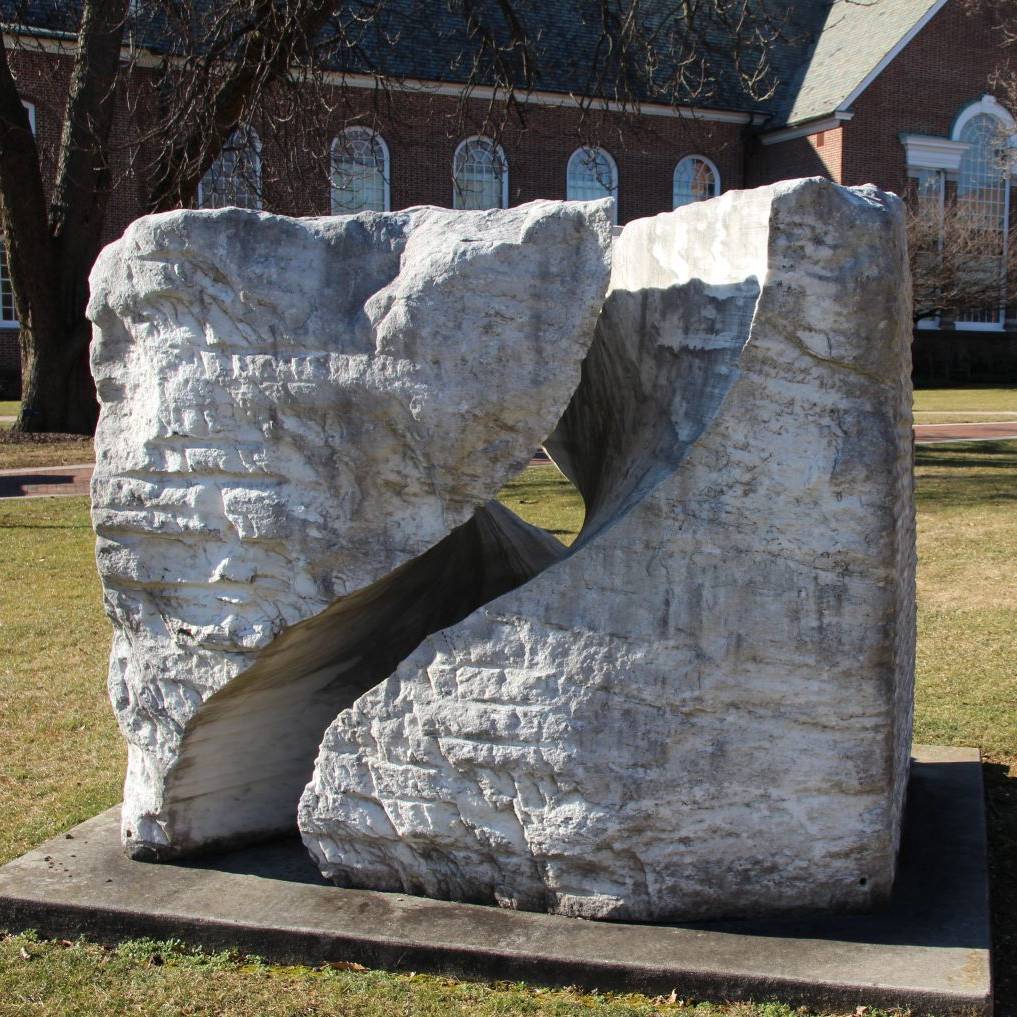Outdoor Sculpture
Franklin & Marshall College has an impressive collection of sculptures across campus. Stop into the Phillips Museum of Art to pick up a Public Art Tour brochure.
Dan Kainz (American, b. 1949). Harmony, 1993. Vermont marble. Gift of the Philip and Muriel Berman Foundation, Allentown, Pennsylvania, #2015.00.1496.
Location: Near College Avenue on the same side as the Steinman College Center
Harmony is made with a compound curve cut, a technique artist Dan Kaintz developed during a sculpture workshop sponsored by the Philips and Muriel Bernman Foundation. He used a wire saw and a turntable to slide the solid block of Vermont marble to create the scallop marks along its sides.

Woods Davy (American, b. 1949). Chesapeake, 1985. Steel and stone. Gift of Stephen D. Moses, Esq. '55, #5058.
Location: In front of Stager Hall, near the Diplomatic Café
Intended to evoke the movement of a river, Chesapeake contrasts the smooth, round surfaces of natural forms with the hard edges of manufactured materials. Davy balances form, gravity, and material to reflect his belief in Zen philosophy. By juxtaposing the movement and rhythm of waves, currents, and clouds, Davy encourages contemplation of the environment.

Linda Cunningham (American, b. 1939). A War Memorial for the 21st Century, 1987, rededicated in 2002. Bronze. Gift of Linda Cunningham, #5455.
Location: South side of the Phillips Museum of Art, near the Kneedler Sculpture Garden
The fragile and decomposing appearance of A War Memorial for the 21st Century, originally titled War Memorial (1987), was made in response to the Vietnam War. In 2002, the piece was rededicated to commemorate the events of 9/11 and to represent contemporary tragedies more broadly. Cunningham made the four bronze forms to contrast with traditional public memorial statuary.
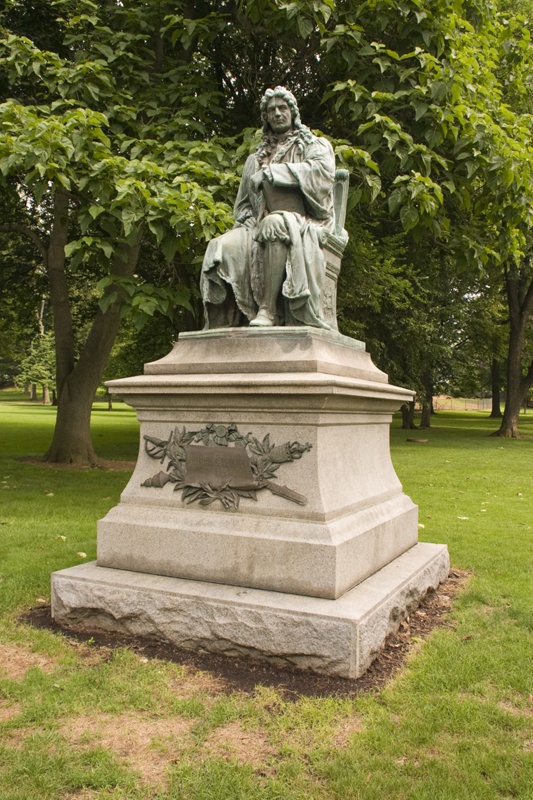
George E. Bissell (American, 1839–1920). Abraham de Peyster, 1895. Cast bronze. Commissioned by John Watts de Peyster (1821–1907), #2073.
Location: Buchanan Avenue near Winter Visual Arts Center
This sculpture depicts the American-born Dutchman Abraham de Peyster, a wealthy merchant of the early modern period. As mayor of New Amsterdam (now Manhattan), de Peyster's roles as a military officer and colonial government are clearly evident through the depiction of the sculpted wig, cloak, army boots, and sword.
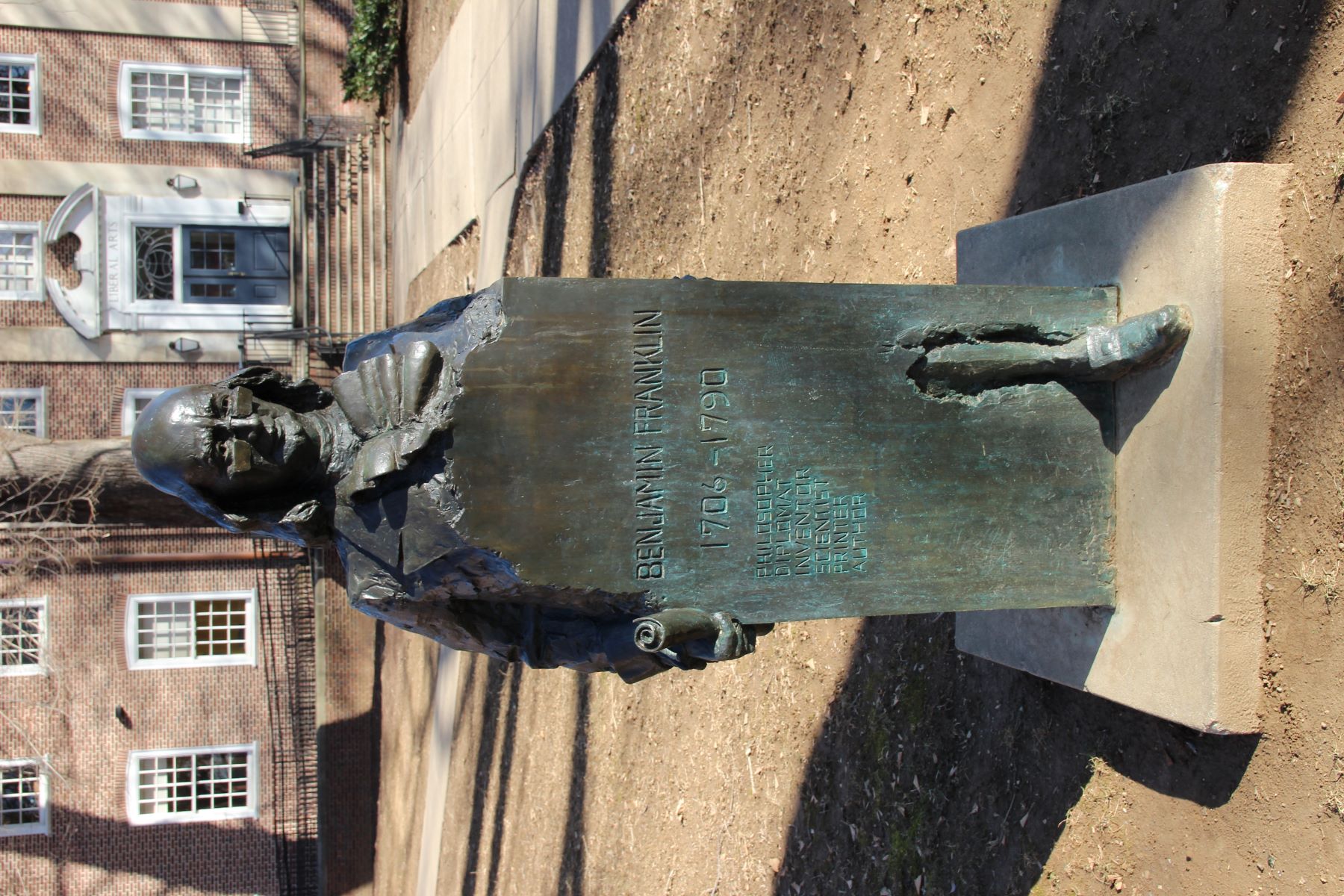
Arlene Love (American, b. 1930). Benjamin Franklin, 1986. Cast bronze. Commissioned by the Philadelphia Regional Alumni Council, 1983, #2230.
Location: North side of the Shadek-Fackenthal Library
Arlene Love was the winner of a competition to depict the College’s namesake as a recognizable and contemporary figure in addition to his role as a Founding Father of the United States. The statue puts Franklin at eye level, rather than on a pedestal, in a box-like form from which he breaks free. Franklin is thus a figure emerging from his historical context into ours. The inscriptions on the sculpture describe Franklin’s achievements: Philosopher, Diplomat, Inventor, Scientist, Printer, Author.
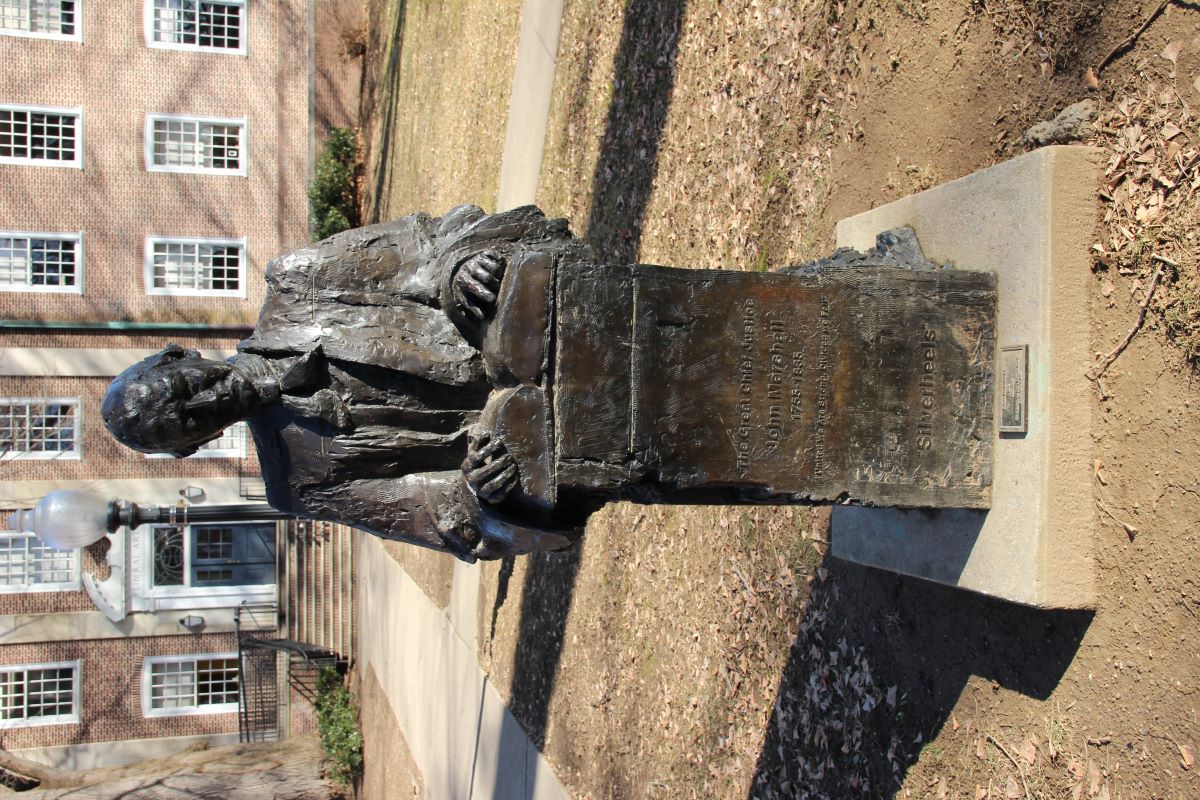
Arlene Love (American, b. 1930). John Marshall, 2000. Cast bronze. Commissioned by the Class of 1999 and Mr. and Mrs. Sidney Dickstein '47, #2015.00.1502.
Location: North side of the Shadek-Fackenthal Library
This statue was commissioned in honor of U.S. Supreme Court Justice John Marshall (1755–1835), whose namesake, Marshall College, was founded in 1836 and merged with Franklin College in 1853 to form Franklin & Marshall College. This statue, like Love’s Benjamin Franklin, is placed at eye-level; Marshall appears to be encased in a lectern-like structure of books. The nickname “silverheels,” inscribed on the lower portion, refers to Marshall’s athletic ability.

Aleko Kyriakos (German, b. 1922). The Phylax (The Sentinel), 1966. Cast bronze. Gift of Nicholas K. Braun P'66, #2076..
Location: South side of the Phillips Museum of Art, near the Kneedler Sculpture Garden
During World War II, Alekos Kyriakos recognized the German Army’s massive power, which inspired his Phylax. The rigid body (a car fender), along with the helmet plume from a water pump handle, creates the imposing quality of the soldier’s armor, juxtaposed with the eyes within the shaded guard of the helmet.
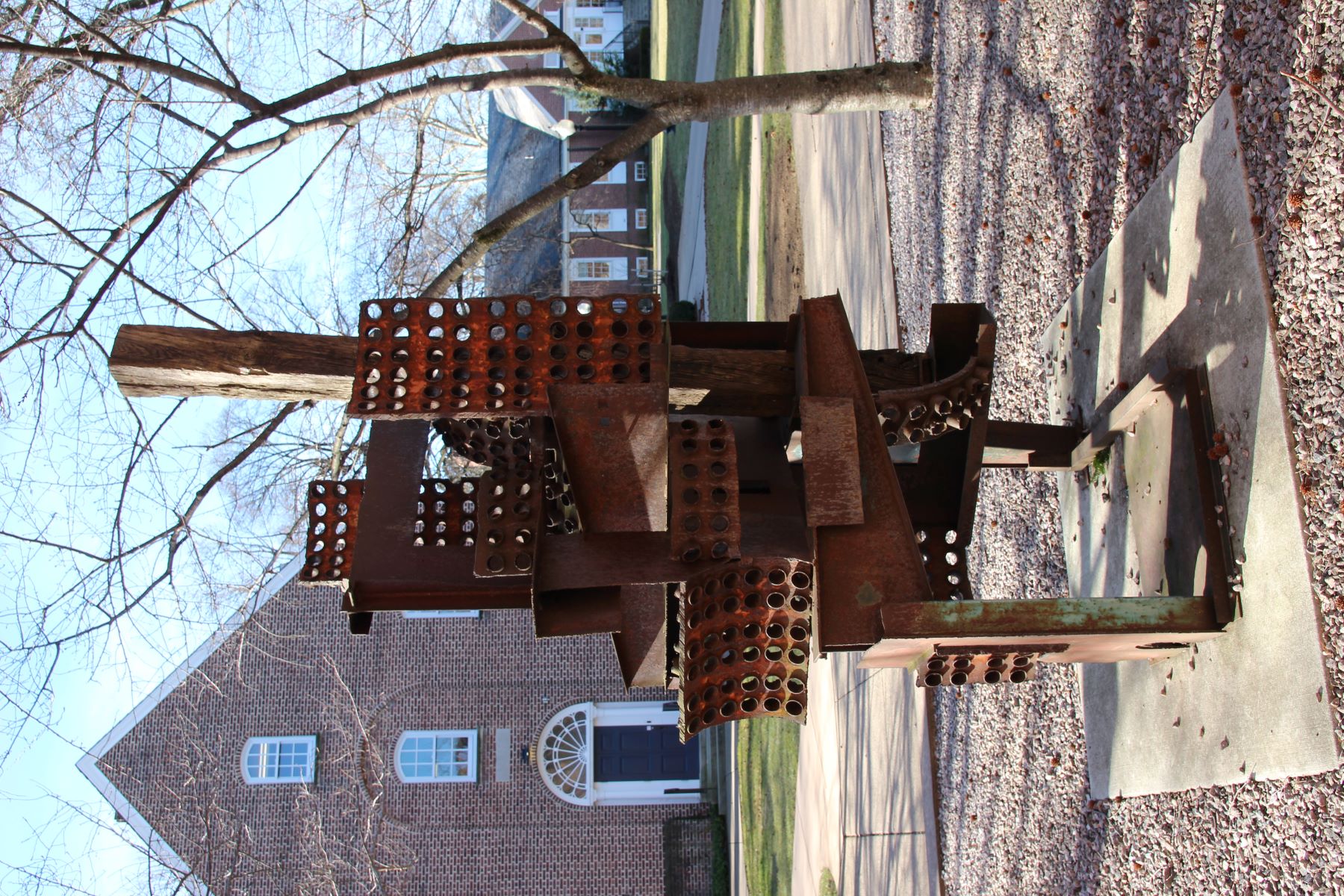
Tedd Pettibon (American, 1958–2014). Castellum, 2009. Steel and wood. The Phillips Museum of Art Collection, #2015.00.1500.
Location: In the Kneedler Sculpture Garden next to the Phillips Museum of Art
Tedd Pettibon’s Castellum contrasts steel's strength and volume with wood's worn surface. The central beam of wood, standing like a soldier, calls to mind a small fort for which the work is named. Pettibon, known for working with found materials, used discarded campus hot-water boilers to make Castellum, making it site-specific.
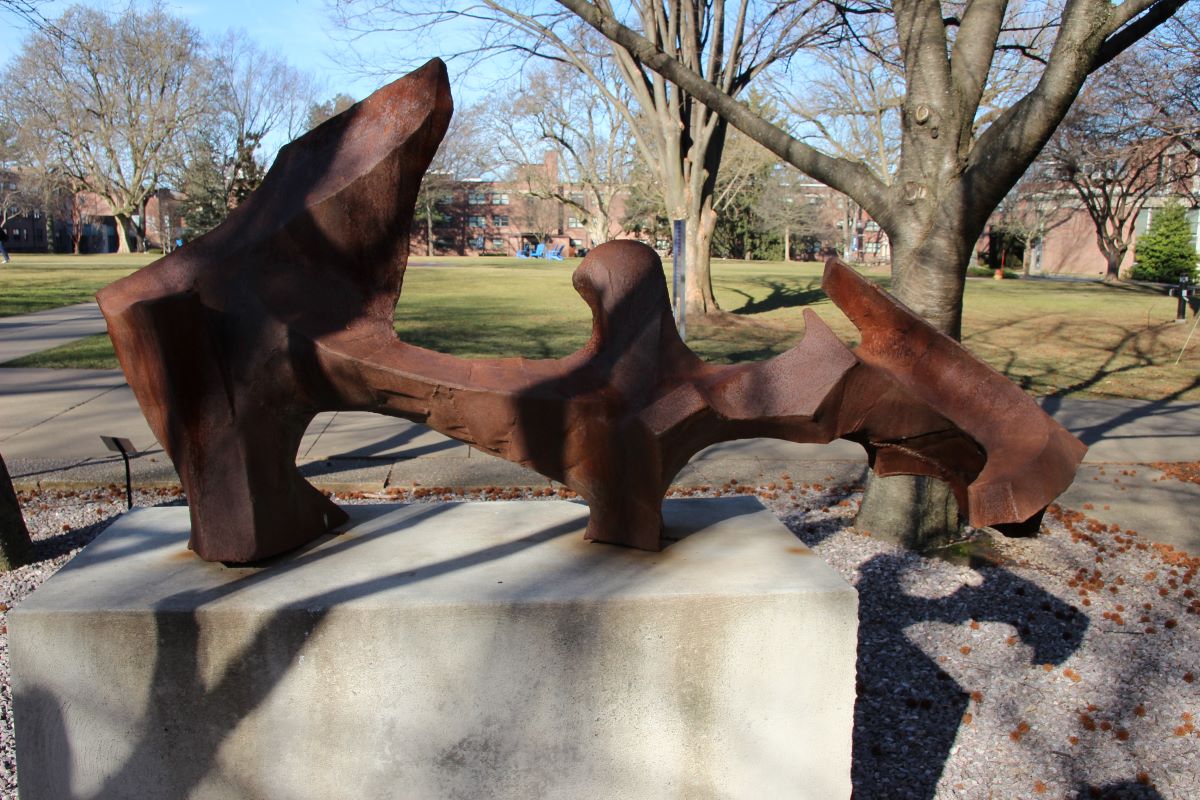
W. Garron Alexander '70 (American, b. 1949). Family, c. 1970. Coated steel. The Phillips Museum of Art Collection, #2015.00.1501.
Location: In the Kneedler Sculpture Garden next to the Phillips Museum of Art
Family, an angular steel sculpture, blends jagged edges with curvilinear lines to create a wave-like form. The work features three distinct shapes that can be read as figures, perhaps a child holding hands with a mother and father. The sculpture was constructed in memory of Edmund Whiting, former chair of the Franklin & Marshall College Art, Art History, and Film Department.
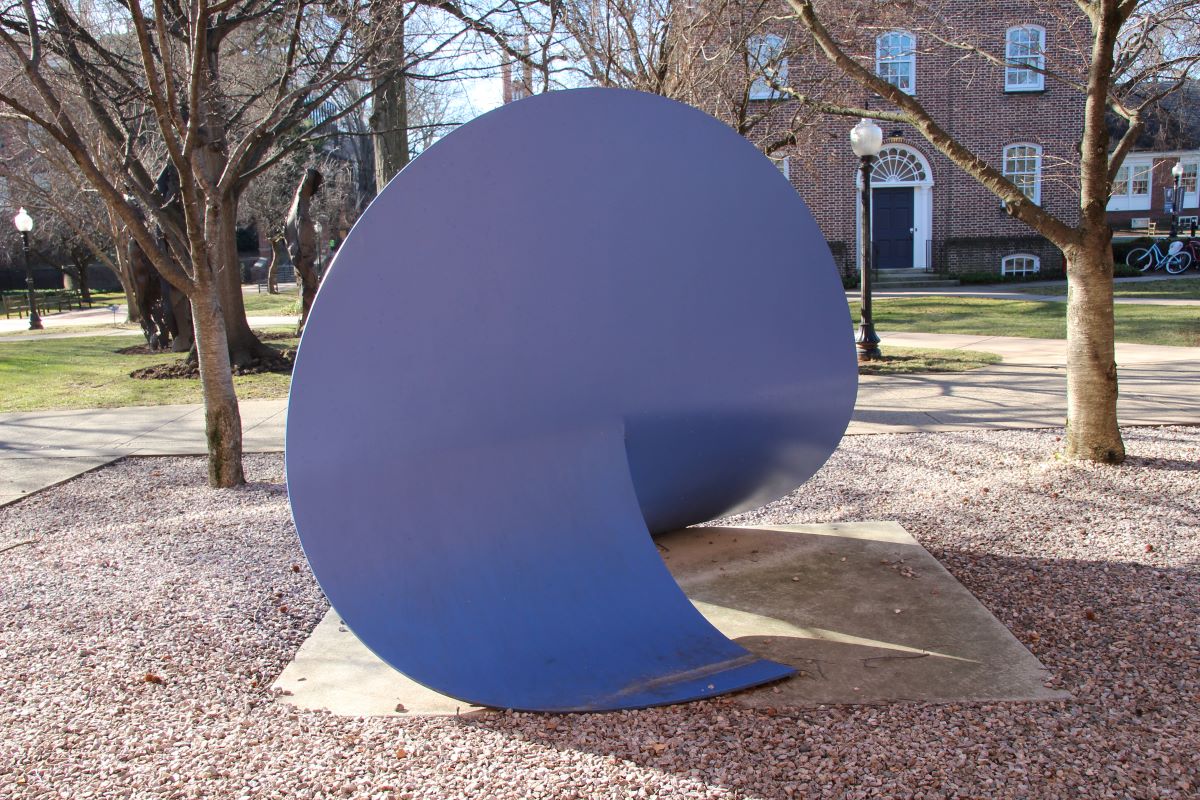
Paul Sisko (American, b. 1942). Split Disk, 1980. Painted steel. Gift of the Philip and Muriel Berman Foundation, Allentown, Pennsylvania, #2015.00.1498.
Location: In the Kneedler Sculpture Garden next to the Phillips Museum of Art
Paul Sisko initially created metal-and-wood, handcrafted, “functional works of art.” Later, he began to make simultaneously “soft” and rigid metal sculptures using a series of separations or cuts. Split Disk demonstrates this process. Starting with a basic shape, Sisko changes the surface by wholly or partially separating, bending, twisting, crushing, or tearing it.
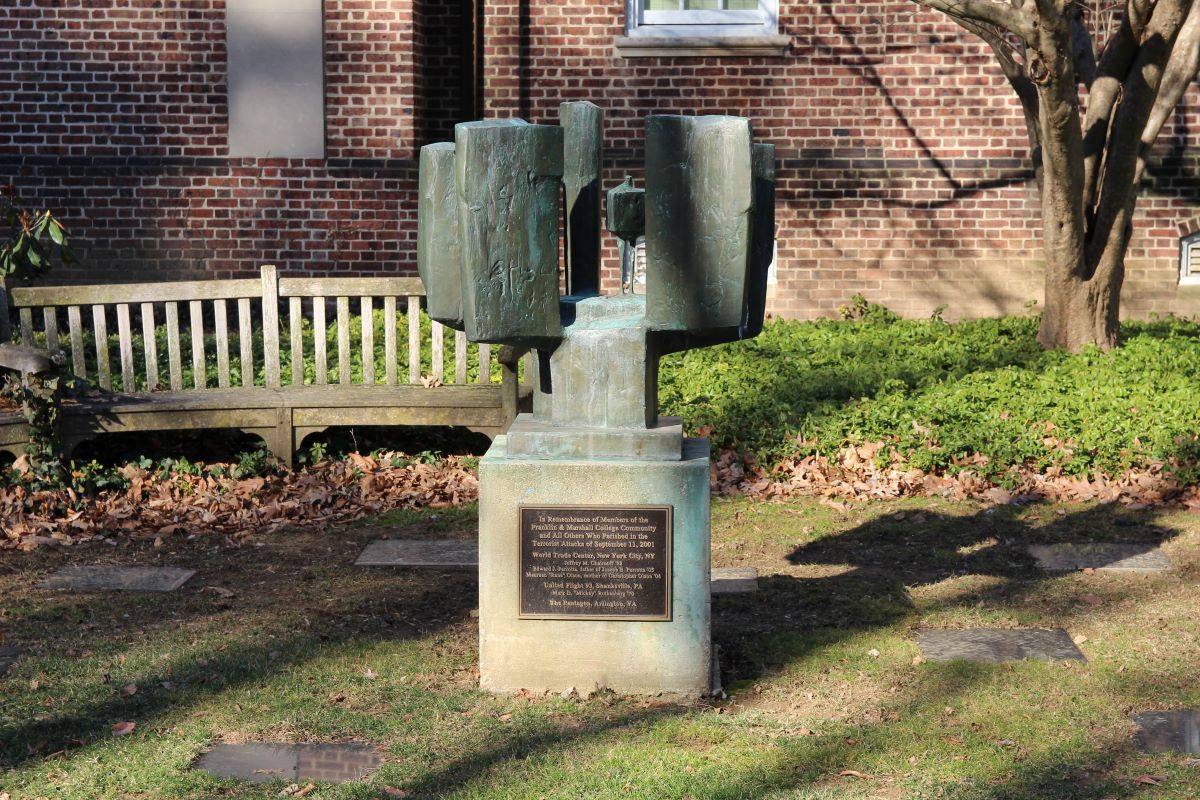
Fritz Koenig (German, 1924–2017). Votive K, 1962–64. Cast bronze. Gift of Robert W. Sarnoff, #2041.
Location: West side of Meyran Hall and the Barshinger Center
The vertical planes of Fritz Koenig’s Votive K surround a small figure like a ring of trees protecting and imposing. This memorial, and the series of granite stepping stones surrounding it, provide space for visitors to stand and contemplate the work, specifically made to commemorate members of the Franklin & Marshall College community who died in the attacks of 9/11.
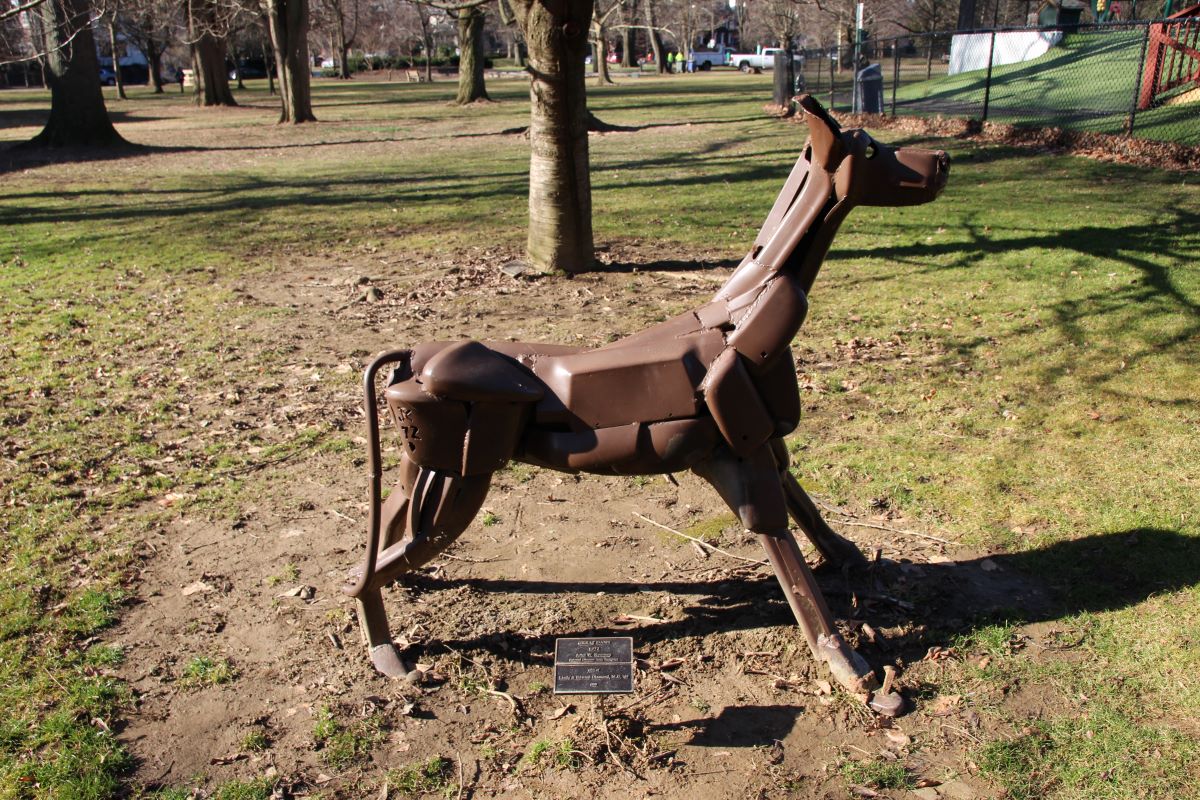
John W. Kearney (American, 1924–2014). Great Dane, 1972. Painted chrome auto bumpers. Gift of Linda and Edward Diamond, M.D. ‘49, # 2015.00.1478.
Location: Between the Winter Visual Arts Center and the Huegel Alumni House, near the dog park
Great Dane, a life-sized sculpture by John W. Kearney, is made from painted chrome automobile bumpers. Kearney was a Chicago-based artist, known for co-founding the Contemporary Art Workshop in 1950. Kearney learned to weld while serving as a sailor in the U.S. Navy during World War II.
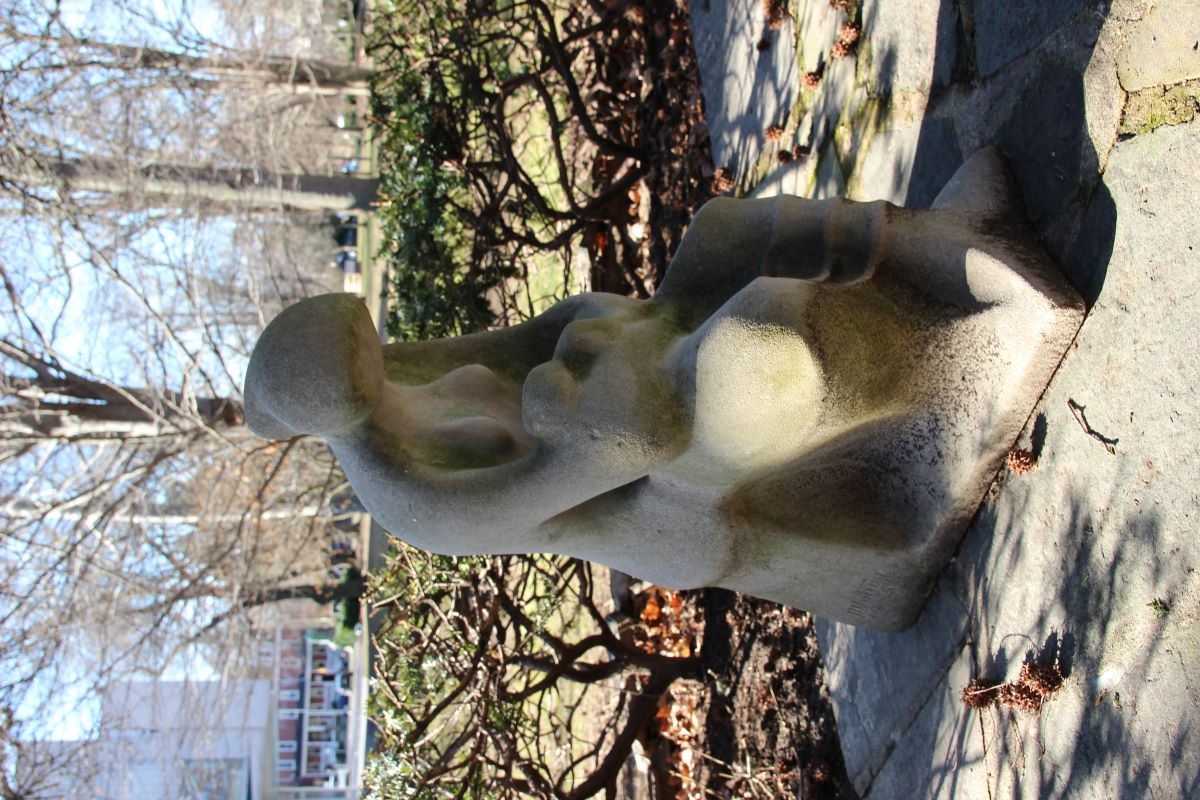
Edmund Whiting (American, 1918–1975). Madonna, c. 1970. Limestone. Gift of Edmund Whiting, #2015.00.1499.
Location: Behind the Huegel Alumni House, near the Winter Visual Arts Center
Madonna is a modest limestone sculpture with curved lines and folds mimicking drapery. Created by renowned artist and sculptor Edmund Whiting, this work and several other pieces of public art were Whiting’s effort to beautify the campus grounds.
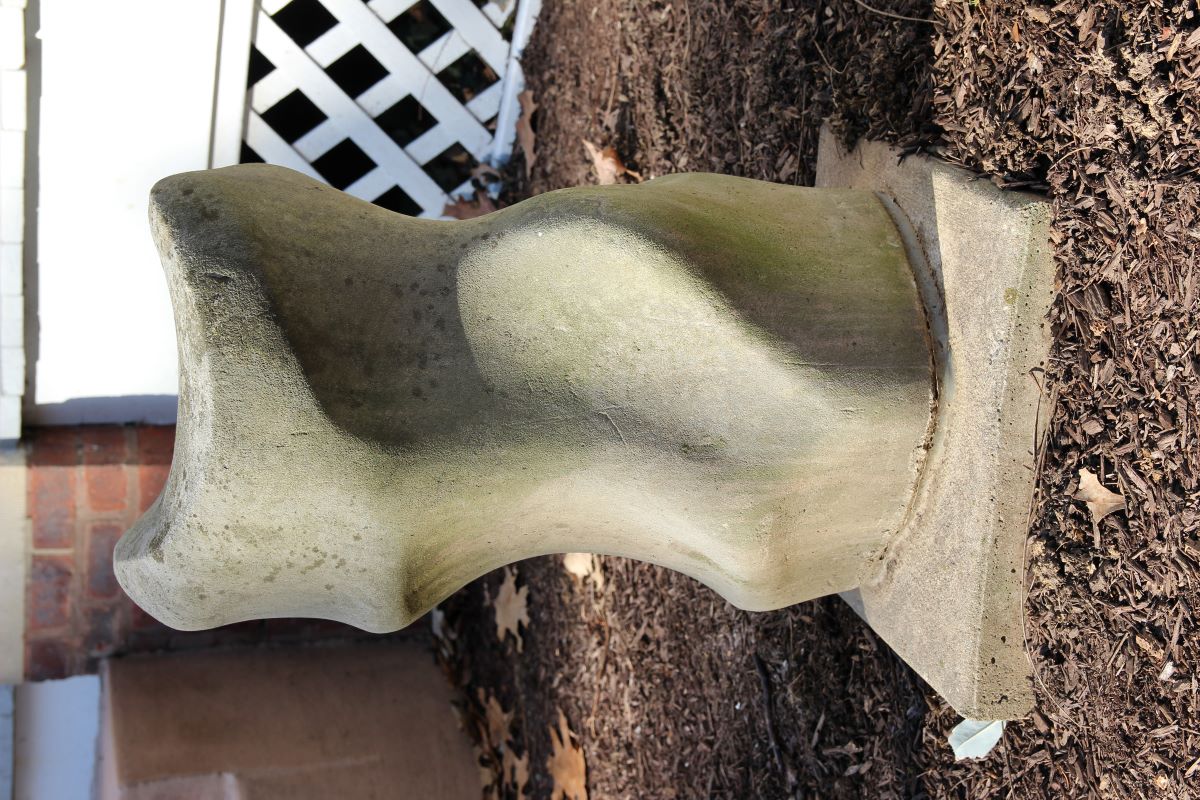
Wilfred Brunner '70 (American, 20th C) and Edmund Whiting (American, 1918–1975). Sandstone Sculpture, 1970. Sandstone. Gift of Edmund Whiting, #2074.
Location: Between the Huegel Alumni House and the Shadek-Fackenthal Library
Sandstone Sculpture, a small work with rounded lines, was begun by Franklin & Marshall student Wilfred Brunner and ultimately completed by his professor, Edmund Whiting. The influence Whiting had on this piece is unknown. Brunner, primarily known for his vibrant paintings and colorful works on paper, creates pieces that encourage open interpretation.
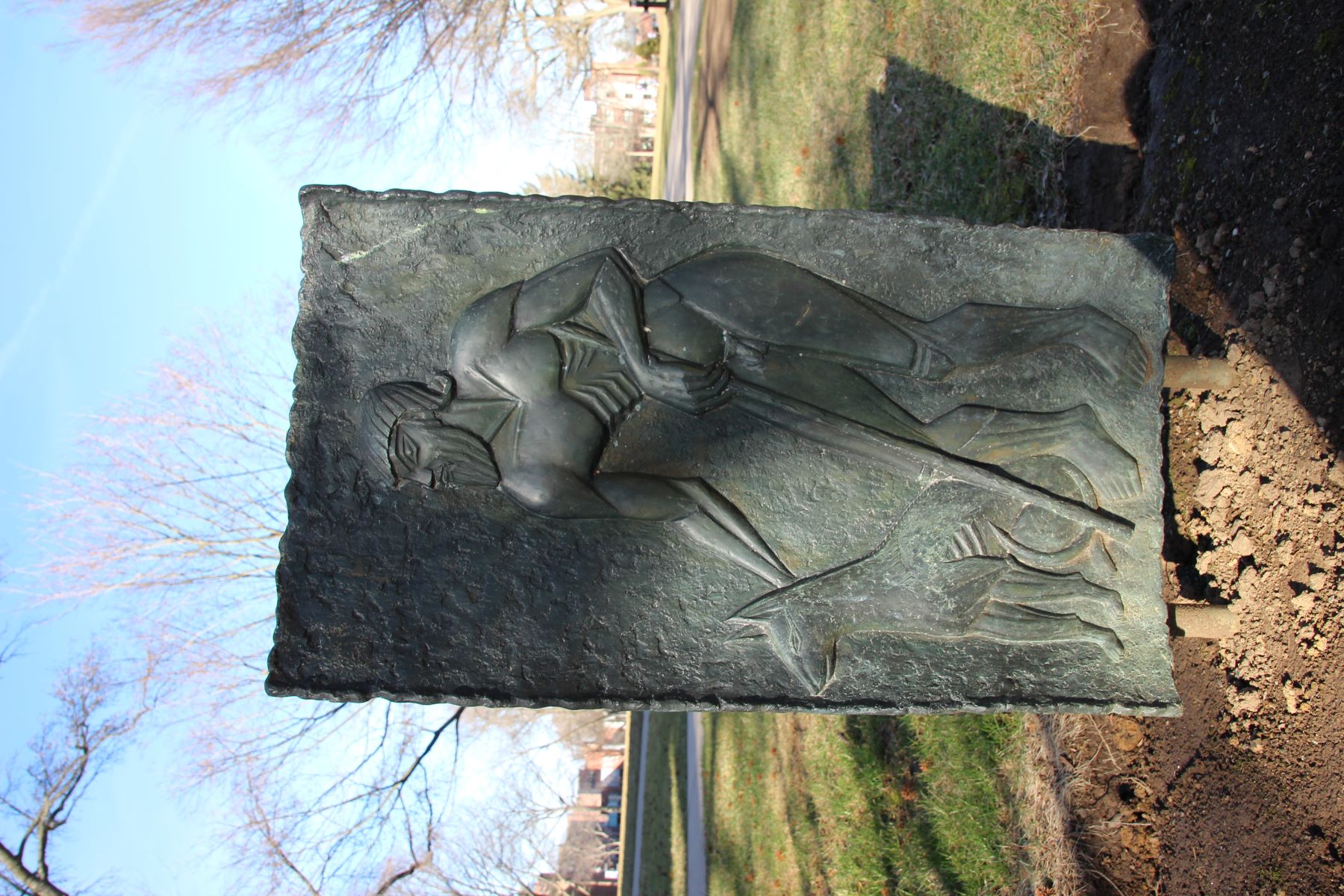
Aleko Kyriakos (German, b. 1922). Bronze Relief of Ancient Figures, late 20th C. Bronze. The Phillips Museum of Art Collection, #2075.
Location: Between Dietz Hall and the Steinman College Center
This Alekos Kyriakos bronze relief sculpture depicts Hercules with a dog on one side and the Ceryneian Hind (deer) on the other. The Golden Hind, known to be faster than an arrow, was captured as Hercules’ third labor. The Hind, which is sacred to Artemis (the goddess of the hunt, of animals, and of unmarried women), was a massive animal with golden antlers and brass hooves.
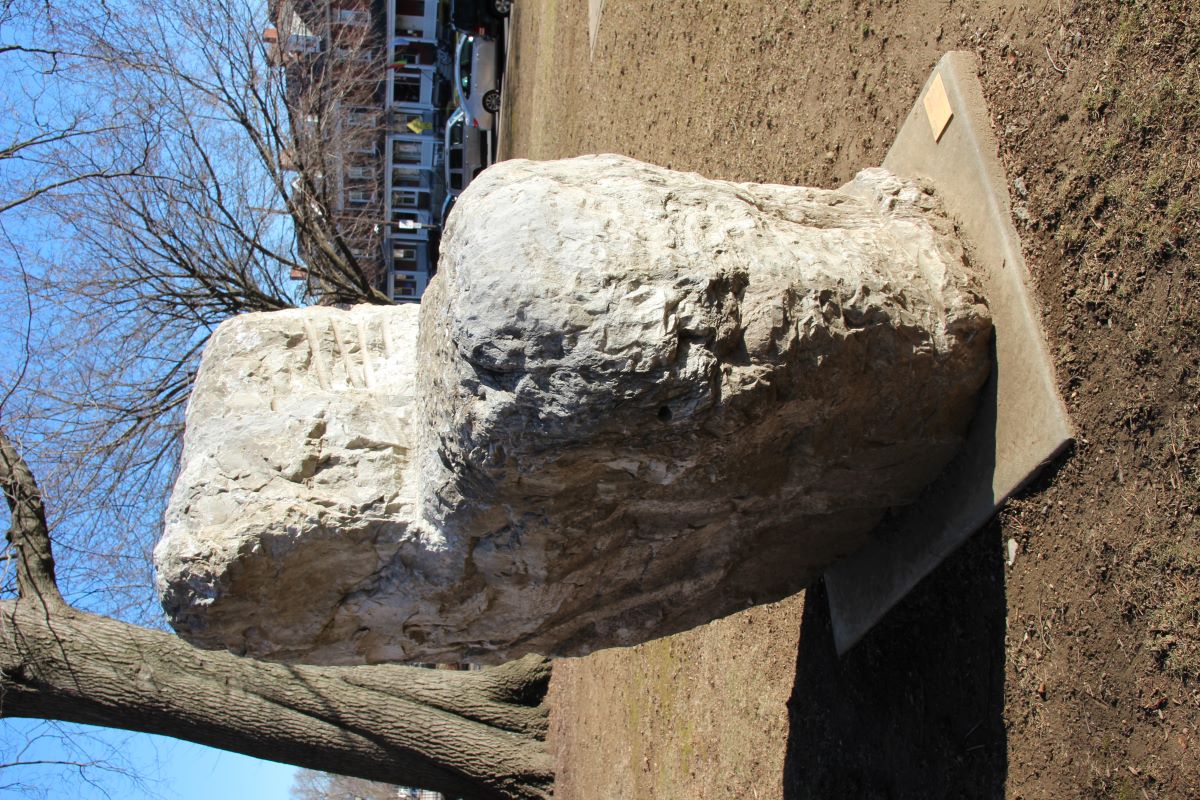
Berj Krikorian (American, b. 1956). Marble Bench, 1993. Vermont marble. Gift of the Philip and Muriel Berman Foundation, Allentown, Pennsylvania, #2015.00.1497.
Location: Near College Avenue in between the Barshinger Center and Stager Hall
In Marble Bench, Berj Kriokorian exploited the natural bulging and voluminous shape of his material by repeatedly marking its surface with a chisel. Krikorian made this chair-like piece in 1993, at a three-week-long workshop sponsored by the Phillip and Muriel Berman Foundation.
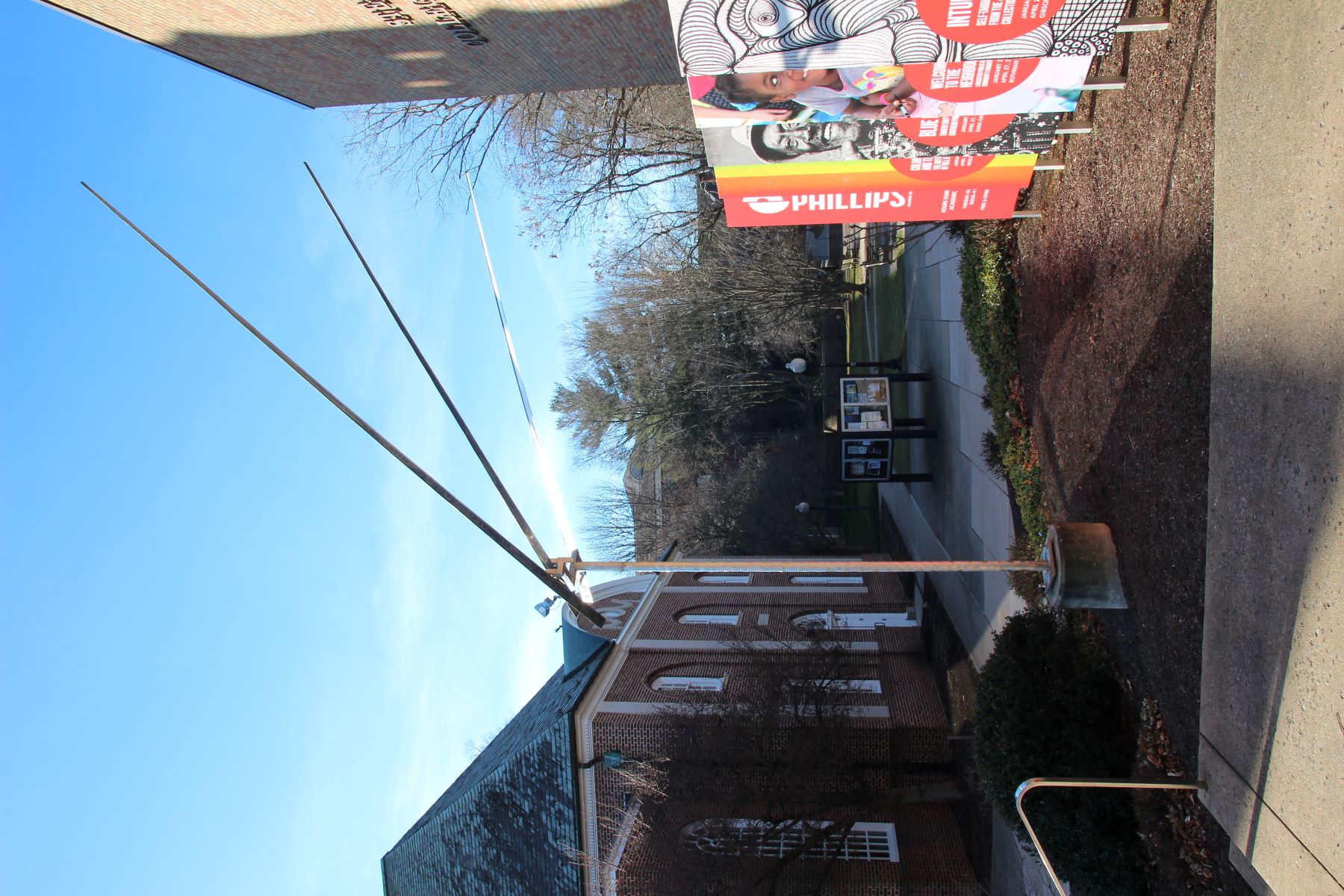
George Rickey (American, 1907–2002). Three Lines Horizontal, 1965. Stainless steel. Gift of Robert W. Sarnoff, Board of Trustees Chairman (1967–1971), #2040.
Location: In front of the Steinman College Center
Early in his career, George Rickey had a passion for mechanical construction. This passion was furthered by his World War II service in aircraft and gunnery systems maintenance. Rickey was a pioneer in the kinetic sculpture movement, seen in Three Lines Horizontal, with its three weathervanes extending from joints attached to a vertical axis.

